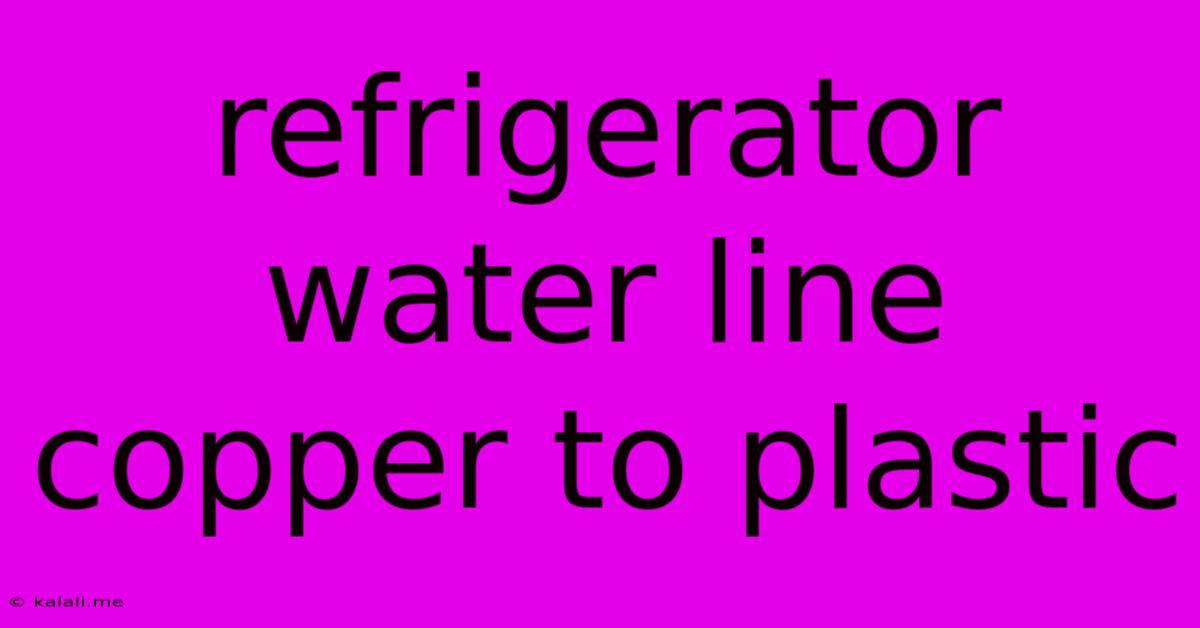Refrigerator Water Line Copper To Plastic
Kalali
Jun 02, 2025 · 3 min read

Table of Contents
Replacing Your Refrigerator Water Line: Copper to Plastic
Replacing your refrigerator's water line, especially transitioning from copper to plastic, might seem daunting, but it's a manageable DIY project that can save you money and improve your appliance's performance. This guide will walk you through the process, highlighting crucial steps and safety considerations. This is a great way to update your older refrigerator and ensure safe, clean water dispensing.
Why Replace Your Refrigerator Water Line?
Older refrigerators often utilize copper water lines. While durable, copper lines can be prone to corrosion over time, potentially leading to leaks and contaminated water. A plastic water line, usually made of polyethylene, offers several advantages: it's more flexible, less susceptible to corrosion, and generally easier to install. A damaged or corroded water line can also affect the efficiency of your ice maker, leading to poor ice production. Regular maintenance, including replacing the water line, prevents these problems.
Tools and Materials You'll Need:
- New plastic water line: Ensure it's the correct length and diameter for your refrigerator model.
- Water shut-off valve: Locate this valve near your home's water supply.
- Adjustable wrench: To tighten connections.
- Pliers: For gripping and maneuvering the tubing.
- Basin wrench: Useful for accessing hard-to-reach connections.
- Pipe cutter or tubing cutter: To neatly cut the copper line (if replacing an existing copper line).
- Safety glasses: Protect your eyes from flying debris.
- Gloves: Protect your hands.
- Cloth or towels: To clean up any spills.
- Optional: Teflon tape: For additional sealing on connections (check your new plastic tubing instructions; some already include a pre-sealed fitting).
Step-by-Step Guide to Replacing Your Refrigerator Water Line:
- Turn off the water supply: Locate the water shut-off valve and turn it completely off. This is crucial to prevent water damage during the replacement process.
- Disconnect the old water line: Carefully disconnect the old water line from both the refrigerator and the water supply. If using a copper line, a pipe cutter will provide a clean cut. Be prepared for some residual water in the line.
- Prepare the new plastic water line: Measure and cut the new plastic tubing to the correct length, leaving some slack for easy connection.
- Connect the new water line to the water supply: Attach the new plastic water line to the water supply valve. Tighten the connection securely using an adjustable wrench. If using Teflon tape, wrap it neatly around the threads before tightening.
- Connect the new water line to the refrigerator: Connect the other end of the plastic water line to your refrigerator's water inlet valve. Again, tighten securely. Consult your refrigerator's manual for specific connection instructions.
- Turn the water supply back on: Slowly turn the water supply valve back on and check for any leaks around the connections. If you see any leaks, carefully tighten the connections again.
- Test the water dispenser and ice maker: Once you're sure there are no leaks, test your refrigerator's water dispenser and ice maker to ensure they are functioning correctly.
Troubleshooting:
- Leaks: If you encounter leaks, immediately turn off the water supply and re-tighten the connections. If the leaks persist, you may need to replace the connection fittings or check for damaged tubing.
- Low water pressure: Check your home's main water supply pressure.
- No water dispensing: Ensure the water line is properly connected to both the refrigerator and water supply and that the water supply is turned on.
Safety Precautions:
- Always turn off the water supply before starting the project.
- Wear safety glasses and gloves to protect yourself from injury.
- Be careful when handling sharp tools like pipe cutters.
- If you're unsure about any part of this process, consult a qualified plumber.
By following these steps and prioritizing safety, you can successfully replace your refrigerator's water line, ensuring clean, reliable water dispensing for years to come. Remember to consult your refrigerator's manual for specific instructions and diagrams related to your model. This upgrade will enhance both the functionality and longevity of your appliance.
Latest Posts
Latest Posts
-
Movie About A Kid Who Is Making A Movie
Jun 04, 2025
-
Fridge Not Cold Enough In Hot Weather
Jun 04, 2025
-
Arithmetic Overflow Error Converting Float To Data Type Numeric
Jun 04, 2025
-
How Long Do Galvanized Pipes Last
Jun 04, 2025
-
War Of The Planet Of The Apes Subtitle
Jun 04, 2025
Related Post
Thank you for visiting our website which covers about Refrigerator Water Line Copper To Plastic . We hope the information provided has been useful to you. Feel free to contact us if you have any questions or need further assistance. See you next time and don't miss to bookmark.